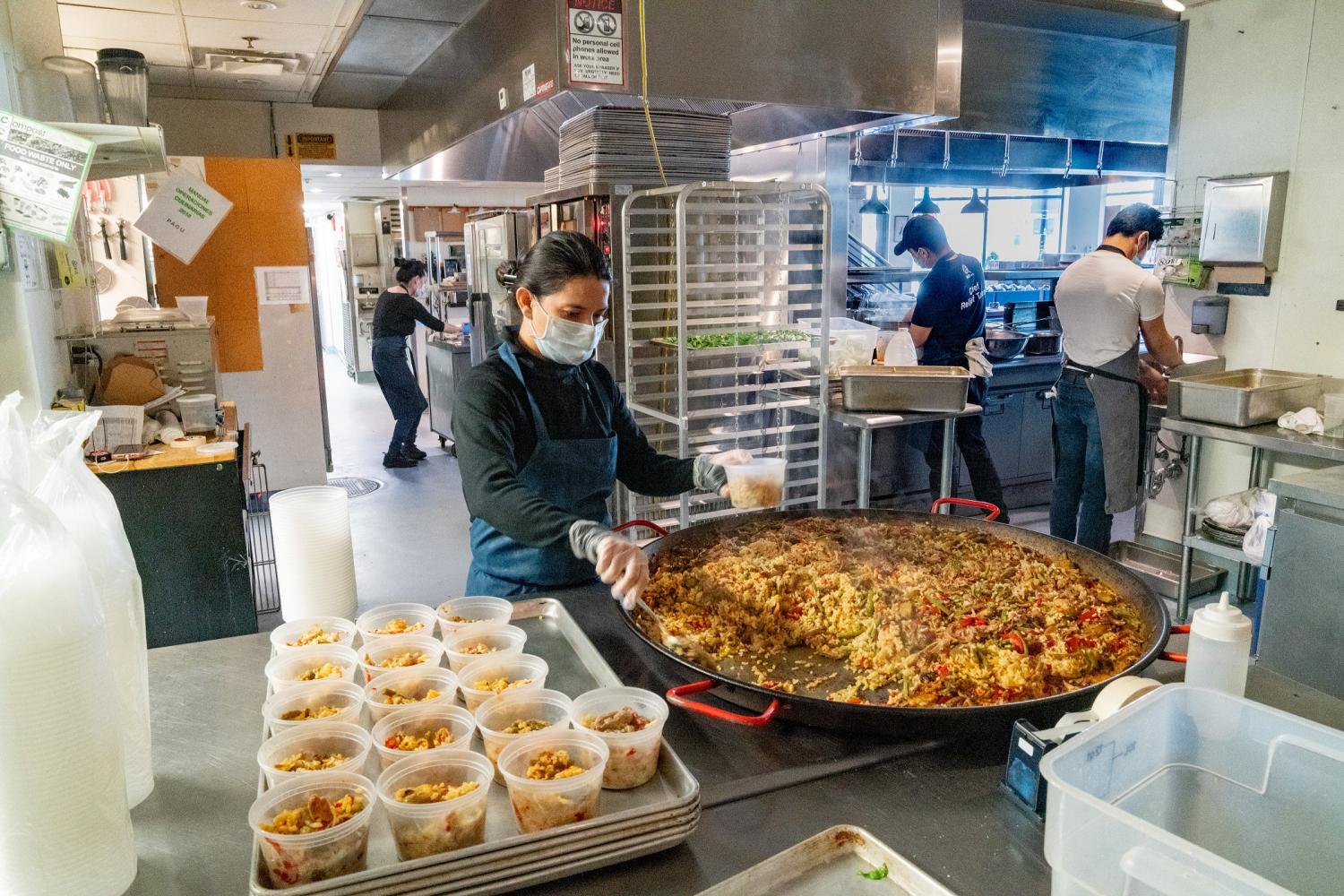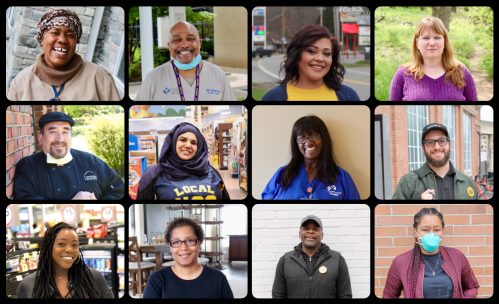As the COVID-19 pandemic continues, America’s frontline workers are still valiantly reporting to their job sites and risking their personal health to keep the economy in motion and the rest of us safe. But to adequately protect these workers, their households, and the communities where they live, employers, policymakers, and other leaders must first agree on exactly who the frontline workforce is.
Most of us continue to rely on media stories and our experiences in daily life to identify frontline workers: butchers at meatpacking plants, bus drivers, grocery workers, and health care providers. But there are millions of more workers on the frontlines; we need clearer metrics to complement these broader narratives. We cannot afford to overlook workers some of us may not see, both now and after COVID-19. Failing to recognize and protect frontline workers harms our public health and economy.
Protecting all essential workers is important, but defining the subset of essential workers who must physically report to their jobs and are most vulnerable to health risks—what we call “frontline” workers—demands greater attention. Which raises the central question: Exactly how many of these workers are commuting each day versus how many can safely stay home?
Using a mix of Department of Homeland Security definitions and Bureau of Labor Statistics data, we have found 50 million people who qualify as frontline workers—a majority of the 90 million people employed in America’s essential industries. This brief builds off of and updates our initial analysis of essential industries from the onset of the COVID-19 pandemic by highlighting how frontline workers earn lower wages, are less educated, and are more likely to be people of color than national averages.
Their size and composition only underscore the need to protect frontline workers. Without more specific definitions, it will be hard to prioritize their safety and determine the cost and eligibility for pandemic-specific benefits, such as additional equipment, insurance, sick leave, hazard pay, and other protections.
To protect today’s frontline workers and to ensure the country is better prepared for the next pandemic, the federal government must create a formal list of essential industries and their frontline workforces. We support policies that will expand health and life insurance, deliver protective equipment, and guarantee sick leave and hazard pay. The following recommendations will help scale and prioritize those policies:
- Congress should designate one or more federal agencies to regularly update the list of frontline occupations and essential industries as it relates to pandemics and other public emergencies. Labor groups, industry leaders, researchers, and public health experts should provide input on these lists. This collective input can help inform and target social, income, and other policies.
- Congress should use these lists to determine the size of the country’s national security stockpile—which includes protective equipment and medical devices—to be able to rapidly safeguard the frontline workforce during a future pandemic.
- Congress should establish a special commission to determine how federal “essential industry” and “frontline occupations” lists should legally relate to related state and local designations. These should specifically designate how federal benefits will flow to individuals based on state and local reopening lists, since the number and categories of workers will grow in time.
Why definitions are important
Since the COVID-19 national lockdowns began, the term “frontline workers” has emerged to capture the vast number of people who must still report to work in the face of unknown threats to their physical health. Yet the term itself is informal; there is no legal definition of a frontline worker.
There is also no set definition of an “essential industry,” another commonly used term since the pandemic began. Ostensibly, an essential industry refers to businesses and other establishments that must stay open during a public health emergency. But in the digital age, telecommuting allows industries to stay open while employees stay home. There is no clarity on how many people working in essential industries are frontline workers who still report to the job site.
Analysts have tried to sort out these competing terms, giving a bit more statistical clarity to which businesses are open and which workers are leaving their homes. In previous analyses, we converted the Department of Homeland Security’s (DHS) original list of essential industries into formal industry codes and employment counts. New York City went a different route, defining frontline workers based on all jobs in six specific industries. Meanwhile, New America combined those approaches, and a team of University of Chicago and Federal Reserve Bank of New York researchers used public datasets to create a list of frontline occupations.
These competing definitions exist because there are no federal standards. Federal law does not designate a specific agency to decide which industries qualify as “essential” during a pandemic, nor which workers in those industries will be unable to work remotely. A lack of clear definitions, in turn, limits the ability of Congress to protect these workers, and continues to lead to widespread confusion and inconsistent protections across the country.
Congress should address this gap immediately—not only to protect workers during this pandemic, but also to prepare for future pandemics and emergencies. In just the past 20 years, the United States escaped the worst of the 2014 Ebola outbreak and SARS in 2003. Yet climate scientists expect more frequent outbreaks of violent diseases in the future. The United States cannot afford to be as flat-footed the next time.
This update introduces a formal definition of both “frontline workers” and “essential industries,” demonstrating a fixed relationship between the two terms.
Defining essential industries
Since the initial release, DHS has regularly updated their federal guidance on which work activities would qualify as essential during the COVID-19 pandemic. Borrowing from their terminology, we define “essential industries” as businesses, organizations, and government agencies whose functions are critical to public health, safety, and economic and national security.
These are establishments that should stay in operation during national emergencies, especially public health crises. This definition also qualifies all workers in those industries—not just those who must report to a job site.
To better gauge employment totals and examine other workforce characteristics, we related the expansive DHS definitions to a discrete list of industry codes. We identified 90 million workers in DHS-designated industries in 2018, according to the Bureau of Labor Statistics (BLS)—equal to nearly 62% of the total U.S. workforce that year.
We were able to categorize employment across 16 different DHS-designated economic sectors, led by 23.2 million workers in state and local government functions, including teachers and protective service officers. Public sector workers represented almost 26% of all essential workers. Another 21 million worked in health care industries, and over 10 million in transportation and logistics. All told, over 54 million workers spanned just these three sectors.

Of course, just because an industry is essential does not guarantee employment for its workers. When U.S. unemployment hit 13.3% in May, unemployment rates were considerably lower in hospitals (3.6%), utilities (5%), and telecommunications (5.7%), but they were higher in industries such as transportation and warehousing (15.6%). Workers may have lost their jobs or simply quit, given the long hours and safety hazards they face in these establishments, and pandemic-related budget cuts will likely lead to additional furloughs and layoffs among government workers.
Still, as the country continues to adapt to COVID-19 and respond to future disruptions, categorizing and counting the number of essential workers is a start to larger policy conversations. Determining which establishments can open only begins to address the experiences of individual workers who must travel to these job sites.
Identifying frontline workers
We define “frontline workers” as employees within essential industries who must physically show up to their jobs. Rather than capture every worker within essential industries, we propose identifying a subset of workers in specific frontline occupations who face a variety of health risks in their workplaces. These workers may frequently be in close physical proximity to customers and colleagues or may be exposed to germs and other potentially hazardous conditions. Gauging vulnerability and health risks remains an imperfect exercise during COVID-19, but one clear threshold is coming into contact with individuals outside one’s household, or anyone commuting to work and facing additional risks.
This statistical approach allows us to highlight the experiences of individual frontline workers— specifically, who they are and how much they earn.
BLS Occupational Employment Statistics provide detail on wages and employment, but a variety of other labor market data, including the American Time Use Survey and O*NET, allow us to explore what types of occupations can work from home and the levels of exposure they face on the job. These data sources do not capture all the potential risks that frontline workers face, but they offer a start to more detailed conversations. Our analysis builds off of recent articles from the World Economic Forum and other organizations to consistently identify frontline occupations that often (1) cannot work from home, and (2) are concentrated in the essential DHS sectors identified above.
Among the 808 total occupations where data is available, we found there are 380 frontline occupations that employ nearly 50 million workers nationally, or around a third (34.5%) of all U.S. workers. From personal care aides to delivery service drivers to retail salespersons, frontline workers make up a majority of the 90 million essential workers. The remaining 40 million “other essential workers” include those in an assortment of office, administrative, and teaching occupations critical to keeping operations going, but have a demonstrated ability to work from home. On average, only about 3.9% of frontline workers can work from home, compared to 64% of other essential workers.
 Frontline workers tend to earn lower wages on average ($21.95 per hour) compared to all U.S. workers ($24.98 per hour), confirming the economic disadvantages many of these workers faced even before the pandemic. While some frontline occupations pay much higher wages—such as physicians ($98.02 per hour) and pharmacists ($59.45 per hour)—the largest occupations tend to be the lowest-paid. For example, millions of people work as cashiers (making $11.17 per hour), food preparation workers ($11.94 per hour), and home health aides ($12.18 per hour). Collectively, 37.3 million workers, or three-quarters of all frontline workers, earn below-average wages.
Frontline workers tend to earn lower wages on average ($21.95 per hour) compared to all U.S. workers ($24.98 per hour), confirming the economic disadvantages many of these workers faced even before the pandemic. While some frontline occupations pay much higher wages—such as physicians ($98.02 per hour) and pharmacists ($59.45 per hour)—the largest occupations tend to be the lowest-paid. For example, millions of people work as cashiers (making $11.17 per hour), food preparation workers ($11.94 per hour), and home health aides ($12.18 per hour). Collectively, 37.3 million workers, or three-quarters of all frontline workers, earn below-average wages.


The combination of lower wages and higher health risks puts many frontline workers in the line of fire. Looking at wages alongside levels of physical proximity shows which frontline occupations are most vulnerable; 126 occupations, employing 25.6 million workers (or about half of all frontline workers), pay below-average wages and face above-average levels of physical proximity, as depicted in the bottom right corner of the scatterplot below. However, just because a frontline occupation falls outside this right corner doesn’t mean those workers are free of risk; determining worker vulnerability will require additional action beyond this brief.

These occupations include cashiers and other workers previously mentioned, as well as bus drivers, packers and packagers, meat and poultry cutters, construction laborers, and bank tellers. Higher-paid health care occupations such as surgeons and anesthesiologists face higher levels of physical proximity (depicted in the top right corner of the scatterplot), but have sizable wage premiums.
This method exposes a cadre of workers that have not yet received significant national attention. The 751,000 landscaping workers earning under $15 per hour on average fall into this most-exposed category, as do the 162,000 laundry workers earning under $12 per hour. Hundreds of thousands of construction, building equipment, and production workers also earn below-average wages and face higher levels of physical proximity.
Frontline workers tend to be more racially diverse, less educated, and male
Pay levels and physical proximity do not fully reveal who these frontline workers are and why they may be more exposed to greater risks overall. Several recent reports have illustrated how COVID-19 disproportionately affects certain segments of the population by education, gender, race, and other demographics. The frontline workforce includes many of these groups.
Frontline workers tend to be the most racially diverse essential workers. COVID-19 has hit Black and Latino or Hispanic workers especially hard, and both are well-represented in the frontline workforce. Together, these two groups account for 33.8% of frontline workers, compared to just 23.7% of other essential workers and 29% of all U.S. workers. Major occupations for Black and Latino or Hispanic frontline workers include industrial truck operators, slaughterers and meatpackers, nursing assistants, and correctional officers. Still, it’s impossible to overlook the high share of frontline workers who are white (61.1%).

Frontline workers tend to be less educated than other essential workers and the wider U.S. workforce, which can limit their ability to qualify for other jobs in the short and long term. Less than half (47.1%) of frontline workers have a high school diploma or less, compared to 17.9% of other essential workers and 32.2% of all U.S. workers. Meanwhile, only 18.2% of frontline workers have a bachelor’s degree or higher, compared to 52.8% of other essential workers and 37.6% of all U.S. workers. Frontline workers in construction and agriculture (including laborers and farmworkers) are among the least educated, with upwards of 85% having a high school diploma or less.

Most frontline workers are male (59.8%). This share is not only higher than the U.S. average for all occupations (53%), but it is also considerably higher than the average for other essential occupations (38.6%). Many of these male workers are concentrated in construction, manufacturing, and the skilled trades. In contrast, female workers are much more concentrated in other essential occupations such as health care, education, and service activities. So while there has been a widespread “she-cession” among workers who have lost their jobs during COVID-19, frontline occupations offer more economic security for men than during the Great Recession’s “man-cession.”

Protecting frontline workers starts with formal definitions
During a public health crisis, it is imperative that policymakers prioritize support for the most vulnerable frontline workers. That means not just counting the number of jobs and industries affected, but focusing on individual workers and the nature of the work they’re conducting.
This update has aimed to do that, demonstrating how two specific, interrelated definitions of “essential industries” and “frontline occupations” could inform workforce policies and protections. The next step is for Congress to put a similar definition into practice.
We recommend Congress designate a specific federal agency or coalition to have long-term responsibility for defining “essential industries” and “frontline occupations” during pandemics and other public emergencies. Three groups are well-positioned to contribute to this effort: the Department of Labor, the Centers for Disease Control and Prevention, and DHS. Whatever the coalition, Congress should mandate this group release a list of qualifying industries (by NAICS code) and occupations (by SOC code) within 30 days, focusing exclusively on the current COVID-19 pandemic. The agencies should convene labor leadership—including unions—alongside business associations and academic experts to provide feedback. The proposed list should also have an expedited public commentary period. Congress should then reserve the option to accept the proposed list via a floor vote or send it back for revisions.
Once approved, Congress should use the list of essential industries and frontline occupations to inform ongoing debates around targeted worker support. We continue to support improved health and life insurance for all frontline workers, and this list should clarify the specific types of risks faced and price-out those policies. The list can also inform debates around federally mandated paid sick leave and hazard pay. A specific sizing of the frontline workforce also enables Congress to authorize public funding for personal protective equipment (PPE) for disadvantaged businesses and to set related federal requirements for other businesses. Continued guidance and support from other federal agencies, including the Occupational Safety and Health Administration (OSHA), can also help establish, communicate, and enforce standards to protect frontline workers—ensuring workplaces remain safe and productive. As the Shift Project detailed, workplace protections are far from universal.
Even with additional protections on the job, many frontline workers are susceptible to layoffs and may struggle to connect with other career pathways. COVID-19 has already cost millions of retail and manufacturing jobs considered essential by DHS, while essential jobs in construction, state and local government, and other activities may be lost in the coming months, too. Congress and the executive branch should continue to monitor these trends closely, including discussions of how to best support disconnected and other prospective frontline workers in training and skills development.
Moving forward, Congress should require the lead agency to update formal definitions every five years, producing annual statistical updates to track employment, wage, and other labor market changes. Congress should use these lists to determine the size of the national security stockpile—including items such as protective equipment and medical devices—in order to rapidly protect the frontline workforce during a future pandemic. While still living through COVID-19, we already know one legacy finding will be the country’s undermanaged stockpile of essential equipment. Regularly tracking the size of the country’s frontline workforce will ensure the future stockpiles better reflect national need.
Finally, Congress should establish a special commission to determine how federal “essential industry” and “frontline occupations” lists should legally relate to independent state and local designations. American federalism was designed so that individual states (and even municipalities, depending on state law) can determine their own reopening strategies. This creates natural tensions with any federal definitions that could designate industries and occupations differently than their state peers. A new federal commission, staffed strictly by state and federal officials, should specifically designate how federal benefits will flow to individuals based on state and local reopening lists. The commission’s central role should determine if federal programs—ranging from PPE to expanded pay—will apply only to “frontline occupations” or to other people now reporting to work.
The COVID-19 pandemic has already inflicted enormous economic and physical pain. Some of the most heartbreaking stories are those of the frontline workers, including people of color and those who have been consistently underpaid. Many of these workers have lost their jobs, contracted the virus, or continue to report to unsafe work conditions. The federal officials sworn to protect them can do more.
Creating formal definitions of frontline workers and the essential industries in which they work is an important, technical step to adopt policies that target the most vulnerable workers. With most experts indicating that a COVID-19 vaccine may not appear for months or years, there is tangible urgency to adopt such technical reforms as soon as possible.








